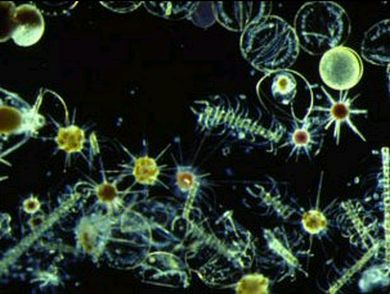 |
| Zebra mussel showing characteristic striping. |
I can't rightfully call myself an invasive species blogger if I don't discuss one of the most well known invasive in North America: the zebra mussel.
Zebra mussels are the small mussels you commonly see covering rocks and piers all over the Great Lakes. Their shells are sharp (the reason I bought good quality water shoes) and have a striped pattern, giving them their name.
They are very similar to another invasive mussel, the quagga mussel. The easiest way to tell the which mussel you're looking at is to place the mussel on a flat surface. If it stays up, you have a zebra mussel (relatively flat underside), it it falls over you have a quagga (rounded underside).
Both invasive mussels hail from the same Ponto-Caspian region of Europe (Black, Caspian and Azov seas) and their expected vector for introduction is ballast water exchange.
 |
| Various types of phytoplankton - food for zebra mussels. |
Zebra mussels are filter feeders, primarily consuming phytoplankton. Large populations of zebra mussels in the Great Lakes and Hudson River reduced the biomass of phytoplankton significantly following invasion (Holland 1993).
Phytoplankton fuel offshore and nearshore foodwebs so a reduction in this essential organism will cause bottom-up effects in the native foodweb most likely causing a reduction in health, condition and ultimately population size of organisms in higher trophic levels.
 |
| Zebra mussels encrusting a water intake pipe. |
- Constriction of flow on water intake pipes, affects heat exchangers, condensers, fire fighting equipment, air conditioning and cooling systems.
- Increased drag on ship due to zebra mussel attachment (higher fuel cost, longer trip duration, etc.)
- Detrimental effects on health and condition of native fish species
- Biomagnification of Polychlorinated Biphenyls (PCBs)
For more information on this organism you can visit the following sites:
http://nas.er.usgs.gov/queries/factsheet.aspx?speciesid=5
http://www.mnr.gov.on.ca/en/Business/Biodiversity/2ColumnSubPage/STEL02_167267.html
http://seagrant.psu.edu/publications/fs/zebraquagga2007.pdf
No comments:
Post a Comment